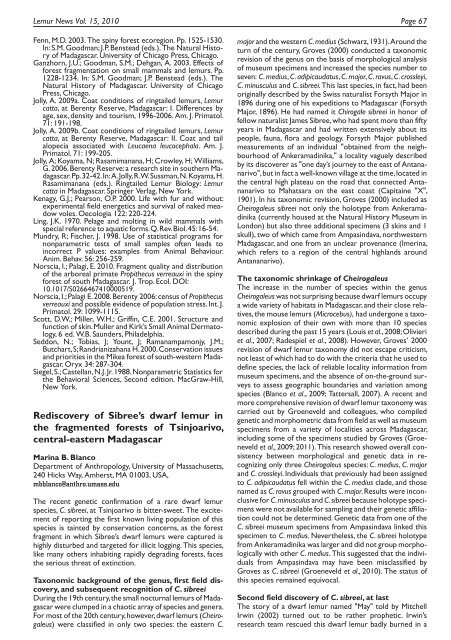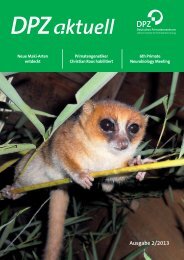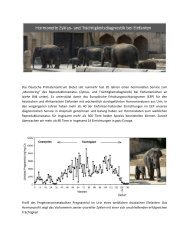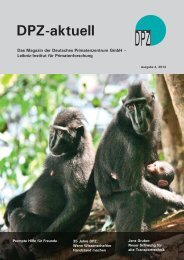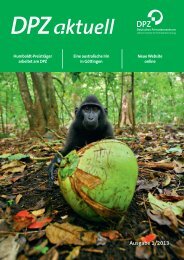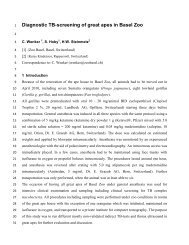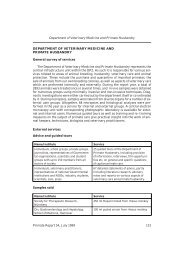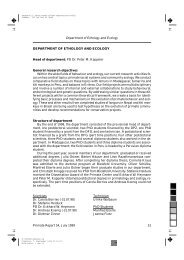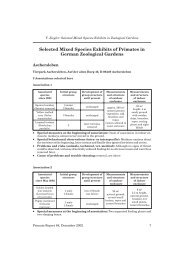Vol. 15 - Deutsches Primatenzentrum
Vol. 15 - Deutsches Primatenzentrum
Vol. 15 - Deutsches Primatenzentrum
You also want an ePaper? Increase the reach of your titles
YUMPU automatically turns print PDFs into web optimized ePapers that Google loves.
Lemur News <strong>Vol</strong>. <strong>15</strong>, 2010 Page 67<br />
Fenn, M.D. 2003. The spiny forest ecoregion. Pp. <strong>15</strong>25-<strong>15</strong>30.<br />
In: S.M. Goodman; J.P. Benstead (eds.). The Natural History<br />
of Madagascar. University of Chicago Press, Chicago.<br />
Ganzhorn, J.U.; Goodman, S.M.; Dehgan, A. 2003. Effects of<br />
forest fragmentation on small mammals and lemurs. Pp.<br />
1228-1234. In: S.M. Goodman; J.P. Benstead (eds.). The<br />
Natural History of Madagascar. University of Chicago<br />
Press, Chicago.<br />
Jolly, A. 2009a. Coat conditions of ringtailed lemurs, Lemur<br />
catta, at Berenty Reserve, Madagascar: I. Differences by<br />
age, sex, density and tourism, 1996-2006. Am. J. Primatol.<br />
71: 191-198.<br />
Jolly, A. 2009b. Coat conditions of ringtailed lemurs, Lemur<br />
catta, at Berenty Reserve, Madagascar: II. Coat and tail<br />
alopecia associated with Leucaena leucocephala. Am. J.<br />
Primatol. 71: 199-205.<br />
Jolly, A; Koyama, N; Rasamimanana, H; Crowley, H; Williams,<br />
G.2006.Berenty Reserve:a research site in southern Madagascar.Pp.32-42.In:A.Jolly,R.W.Sussman,N.Koyama,H.<br />
Rasamimanana (eds.). Ringtailed Lemur Biology: Lemur<br />
catta in Madagascar. Springer Verlag, New York.<br />
Kenagy, G.J.; Pearson, O.P. 2000. Life with fur and without:<br />
experimental field energetics and survival of naked meadow<br />
voles. Oecologia 122: 220-224.<br />
Ling, J.K. 1970. Pelage and molting in wild mammals with<br />
special reference to aquatic forms.Q.Rev.Biol.45:16-54.<br />
Mundry, R; Fischer, J. 1998. Use of statistical programs for<br />
nonparametric tests of small samples often leads to<br />
incorrect P values: examples from Animal Behaviour.<br />
Anim. Behav. 56: 256-259.<br />
Norscia, I.; Palagi, E. 2010. Fragment quality and distribution<br />
of the arboreal primate Propithecus verreauxi in the spiny<br />
forest of south Madagascar. J. Trop. Ecol. DOI:<br />
10.1017/S0266467410000519.<br />
Norscia,I.;Palagi E.2008.Berenty 2006:census of Propithecus<br />
verreauxi and possible evidence of population stress. Int. J.<br />
Primatol. 29: 1099-11<strong>15</strong>.<br />
Scott, D.W.; Miller, W.H.; Griffin, C.E. 2001. Structure and<br />
function of skin.Muller and Kirk’s Small Animal Dermatology,<br />
6th ed. W.B. Saunders, Philadelphia.<br />
Seddon, N.; Tobias, J; Yount, J; Ramanampamonjy, J.M.;<br />
Butchart,S;Randrianizahana H.2000.Conservation issues<br />
and priorities in the Mikea forest of south-western Madagascar.<br />
Oryx 34: 287-304.<br />
Siegel,S.;Castellan,N.J.Jr.1988.Nonparametric Statistics for<br />
the Behavioral Sciences, Second edition. MacGraw-Hill,<br />
New York.<br />
Rediscovery of Sibree’s dwarf lemur in<br />
the fragmented forests of Tsinjoarivo,<br />
central-eastern Madagascar<br />
Marina B. Blanco<br />
Department of Anthropology, University of Massachusetts,<br />
240 Hicks Way, Amherst, MA 01003, USA,<br />
mbblanco@anthro.umass.edu<br />
The recent genetic confirmation of a rare dwarf lemur<br />
species, C. sibreei, at Tsinjoarivo is bitter-sweet. The excitement<br />
of reporting the first known living population of this<br />
species is tainted by conservation concerns, as the forest<br />
fragment in which Sibree’s dwarf lemurs were captured is<br />
highly disturbed and targeted for illicit logging. This species,<br />
like many others inhabiting rapidly degrading forests, faces<br />
the serious threat of extinction.<br />
Taxonomic background of the genus, first field discovery,<br />
and subsequent recognition of C. sibreei<br />
During the 19th century,the small nocturnal lemurs of Madagascar<br />
were clumped in a chaotic array of species and genera.<br />
For most of the 20th century,however,dwarf lemurs (Cheirogaleus)<br />
were classified in only two species: the eastern C.<br />
major and the western C.medius (Schwarz,1931).Around the<br />
turn of the century, Groves (2000) conducted a taxonomic<br />
revision of the genus on the basis of morphological analysis<br />
of museum specimens and increased the species number to<br />
seven: C.medius,C.adipicaudatus,C.major,C.ravus,C.crossleyi,<br />
C. minusculus and C. sibreei. This last species, in fact, had been<br />
originally described by the Swiss naturalist Forsyth Major in<br />
1896 during one of his expeditions to Madagascar (Forsyth<br />
Major, 1896). He had named it Chirogale sibreei in honor of<br />
fellow naturalist James Sibree,who had spent more than fifty<br />
years in Madagascar and had written extensively about its<br />
people, fauna, flora and geology. Forsyth Major published<br />
measurements of an individual "obtained from the neighbourhood<br />
of Ankeramadinika," a locality vaguely described<br />
by its discoverer as "one day’s journey to the east of Antananarivo",but<br />
in fact a well-known village at the time,located in<br />
the central high plateau on the road that connected Antananarivo<br />
to Mahatsara on the east coast (Capitaine "X",<br />
1901). In his taxonomic revision, Groves (2000) included as<br />
Cheirogaleus sibreei not only the holotype from Ankeramadinika<br />
(currently housed at the Natural History Museum in<br />
London) but also three additional specimens (3 skins and 1<br />
skull), two of which came from Ampasindava, northwestern<br />
Madagascar, and one from an unclear provenance (Imerina,<br />
which refers to a region of the central highlands around<br />
Antananarivo).<br />
The taxonomic shrinkage of Cheirogaleus<br />
The increase in the number of species within the genus<br />
Cheirogaleus was not surprising because dwarf lemurs occupy<br />
a wide variety of habitats in Madagascar,and their close relatives,the<br />
mouse lemurs (Microcebus), had undergone a taxonomic<br />
explosion of their own with more than 10 species<br />
described during the past <strong>15</strong> years (Louis et al.,2008;Olivieri<br />
et al., 2007; Radespiel et al., 2008). However, Groves’ 2000<br />
revision of dwarf lemur taxonomy did not escape criticism,<br />
not least of which had to do with the criteria that he used to<br />
define species, the lack of reliable locality information from<br />
museum specimens, and the absence of on-the-ground surveys<br />
to assess geographic boundaries and variation among<br />
species (Blanco et al., 2009; Tattersall, 2007). A recent and<br />
more comprehensive revision of dwarf lemur taxonomy was<br />
carried out by Groeneveld and colleagues, who compiled<br />
genetic and morphometric data from field as well as museum<br />
specimens from a variety of localities across Madagascar,<br />
including some of the specimens studied by Groves (Groeneveld<br />
et al., 2009; 2011). This research showed overall consistency<br />
between morphological and genetic data in recognizing<br />
only three Cheirogaleus species: C. medius, C. major<br />
and C. crossleyi. Individuals that previously had been assigned<br />
to C. adipicaudatus fell within the C. medius clade, and those<br />
named as C.ravus grouped with C.major.Results were inconclusive<br />
for C.minusculus and C.sibreei because holotype specimens<br />
were not available for sampling and their genetic affiliation<br />
could not be determined. Genetic data from one of the<br />
C. sibreei museum specimens from Ampasindava linked this<br />
specimen to C. medius. Nevertheless, the C. sibreei holotype<br />
from Ankeramadinika was larger and did not group morphologically<br />
with other C. medius. This suggested that the individuals<br />
from Ampasindava may have been misclassified by<br />
Groves as C. sibreei (Groeneveld et al., 2010). The status of<br />
this species remained equivocal.<br />
Second field discovery of C. sibreei, at last<br />
The story of a dwarf lemur named "May" told by Mitchell<br />
Irwin (2002) turned out to be rather prophetic. Irwin’s<br />
research team rescued this dwarf lemur badly burned in a


